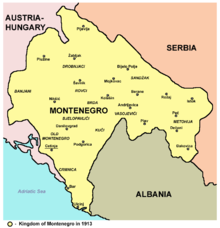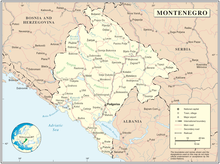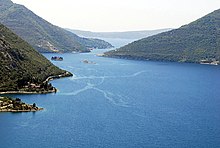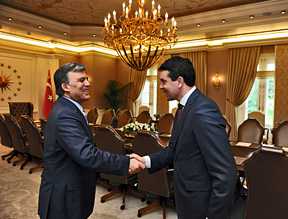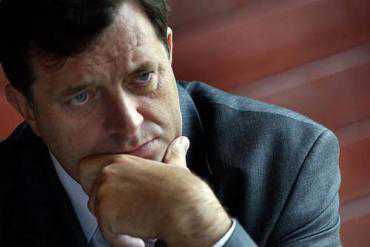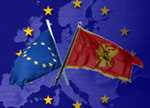 Good news for Montenegro: the European Council has endorsed the decision to open accession negotiations, this very afternoon.
Good news for Montenegro: the European Council has endorsed the decision to open accession negotiations, this very afternoon.
Avrupa Konseyi, Karadağ ile üyelik müzakerelerine başlama kararı aldı.
Karadağ
| Karadağ Cumhuriyeti |
Република Црна Гора
Republika Crna Gora |
 |
 |
| Bayrak |
Arma |
|
Ulusal Marş: Oj, svijetla majska zoro
“Mayısın aydınlık şafağı!” |
|
|
| Başkent(en büyük ) |
Podgorica
 42°47′N 19°28′E 42°47′N 19°28′E |
| Resmî dil(ler) |
Karadağca |
| Milliyet |
Karadağlı |
| Yönetim biçimi |
Cumhuriyet |
| – Başkan |
Filip Vujanović |
| – Başbakan |
Milo Đukanović |
| Kuruluş |
|
| – Kurucu Karadağ Prensliği |
1 Ocak 1852 |
| – Osmanlı İmparatorluğu tarafından Tanıma |
1878 |
| – İlanı Birleşik Krallık |
28 Ağustos 1910 |
| – Bağımsızlık sahibi Sırbistan ve Karadağ |
3 Haziran, 2006 |
| – Tanınma |
8 Haziran, 2006 |
| Yüzölçümü |
|
| – Su (%) |
1.5 |
| Nüfus |
|
| – Temmuz 2007 tahmini |
684,736[1] (160.) |
| – 2003 sayımı |
620,145 |
| GSYİH (SAGP) |
2005 |
| – Toplam |
11,458 milyar $ (99) |
| – Kişi başına |
3,800$ (150) |
| İGE |
0.999[2] (very high) (2004) |
| Para birimi |
Euro2 (EUR) |
| Zaman dilimi |
CET (UTC+1) |
| – Yaz |
CEST (UTC+2) |
| Internet TLD |
.yu (.me)3 |
| Telefon kodu |
382 |
Karadağ (Karadağca:  Crna Gora (yardım·bilgi), Црна Гора), Güneydoğu Avrupa’da bir ülkedir. Doğusunda Arnavutluk ve Kosova, kuzeyinde Sırbistan, batısında Hırvatistan, Bosna-Hersek, güneyinde Adriyatik Denizi yer alır. Başkenti, Podgorica’dır (eskiden Titograd). Anayasasında Karadağ “demokratik, refah ve çevreci bir ülke” olarak tanımlanır.[3]
Crna Gora (yardım·bilgi), Црна Гора), Güneydoğu Avrupa’da bir ülkedir. Doğusunda Arnavutluk ve Kosova, kuzeyinde Sırbistan, batısında Hırvatistan, Bosna-Hersek, güneyinde Adriyatik Denizi yer alır. Başkenti, Podgorica’dır (eskiden Titograd). Anayasasında Karadağ “demokratik, refah ve çevreci bir ülke” olarak tanımlanır.[3]
Karadağ, eski Yugoslavya’yı oluşturan altı cumhuriyetten biriydi. Yugoslavya’nın parçalanmasından sonra Karadağ, Sırbistan’ın zorlamasıyla yeni Yugoslavya’ya katılmıştır. Karadağ’ın çabalarıyla 2003 yılında Sırbistan-Karadağ olarak daha esnek bir federasyon çatısı oluşturulmuştur. Karadağ, 21 Mayıs 2006 Pazar günü yapılan referandumda çıkan % 55,5’lik evet oyu ile ise bağımsız olma kararı almıştır. 3 Haziran 2006’da ise Karadağ Parlamentosu, referandumda çıkan sonuca dayanarak Karadağ’ın bağımsızlığını ilân etti.
|
Konu başlıkları
- 1 Tarih
- 2 Etnik yapı
- 3 Önemli şehirleri
- 4 Sportif başarılar
- 5 Ayrıca bakınız
- 6 Notlar
- 7 Dış bağlantılar
|
Tarih
-
Ana madde: Karadağ tarihi
Karadağ’ın eski halkı Arnavutlardan oluşur. VII. yüzyılda, İmparator Herakliyus zamanında, Sırplar da oraya yerleştirilmiştir. Osmanlılar Rumeli’ye geçip fetihlere giriştikleri sıralarda, Karadağ, Venedik Cumhuriyeti’nin tabiiyetinde idi. Osmanlı Devleti’nin Karadağ’daki fetihleri Sultan I. Murad dönemine rastlar. Zira ilk Osmanlı-Karadağ çatışması da I. Murat döneminde yaşanmıştır. İkinci Osmanlı-Karadağ çatışması Sultan I. Bayezid döneminde olmuştur. Bu seferde Osmanlı kuvvetleri Üsküp’ten çıkıp Zveçan ve Yeleç üzerinden Lim ve Tara nehirlerine kadar ulaşmıştır. Osmanlı Devleti’nin Karadağ’daki asıl fetihleri ise Fatih Sultan Mehmet döneminde olmuştur. Aslında Osmanlı Karadağ’ı tam olarak hakimiyetine almadı. Fatih, Karadağ’a bir nevi özerklik statüsü verdi ve bu durum Karadağlılar tarafından 1878 yılında Osmanlı’dan ayrılana kadar kullanıldı. Karadağlılar Osmanlı Devleti’nin hakimiyetine girişinden itibaren çok sayıda isyan çıkartmışlardır. Örneğin 1711, 1712, 1714 isyanlarını çıkartmışlardır. Bununla birlikte Hersek isyanına da destek vermişlerdir.[4]
1877-78 Osmanlı-Rus Savaşı’nda Rusya’nın yanında yer alan Karadağ, Osmanlı ordusunun önemli bir kısmını Balkanlarda meşgul etmiş ve savaşın Rusya lehine dönmesinde büyük bir etken olmuştur. Savaş sonrası imzalanan Ayastefanos ve hemen ardından Berlin Antlaşması’yla bağımsızlığını kazanan Karadağ, böylece devletler platformunda yerini almıştır. Bağımsızlığını kazanmasının ardından onu ilk tanıyan Osmanlı Devleti olmuştur[5]. Türkiye’de yaşayan Boşnakların önemli bir kısmı 1910’lu yıllarda Karadağ’dan gelmiştir.
Etnik yapı
1991 sayımına göre Sırplar Sırbistan-Karadağ federasyonunun toplam nüfusun % 69’nu oluşturmaktaydı. Karadağlılar ise toplam nüfusun % 5’ni, Karadağ nüfusunun % 62’sini oluşturuyordu. Slav olmayan Arnavut azınlık ülkedeki 2. büyük gruptu ve resmi tahminlere göre toplam nüfusa oranları % 17’ydi.
1965’ten sonra Sırbistan ve Karadağ’dan gelişmiş Avrupa ülkelerine ve Kuzey Amerika’ya sürekli göç yaşanmıştır. Eski Yugoslavya’nın dağılmasını ve Hırvatistan ile Bosna-Hersek’teki savaşı takip eden yıllarda göç Sırbistan ve Karadağ’a yönelmiştir. Mülteci sayımı sonucunda 1996 yılı ortalarında 566.200’ü mülteci statüsünde olan 646.000 kişi tespit edilmiştir. 79.700 kişi ise diğer cumhuriyetlerde yaşayan Sırp ve Karadağlılar ya da Yugoslavya’ya mülteci olarak gelip Yugoslav vatandaşlığına geçmiş kişilerdir.
Önemli şehirleri
2003 NÜFUS SAYIMINA GÖRE
- Podgorica (başkent; 169.132)
- Nikšić (58.212)
- Pljevlja (21.377)
- Bijelo Polje (15.883)
- Herceg Novi (12.739)
- Berane (11.776)
- Cetinje (Çetine) (15.137) Eski Krallık Başkenti
- Budva (10.918)
- Tivat (9.467)
- Rožaje (9.121)
- Dobrota (8.169)
- Danilovgrad (5.208)
- Bijela (3.748)
- İgalo (3.754)
- Kolašin (2.989)
Sportif başarılar
Karadağ Millî Futbol Takımı, 7 Ekim 2011 tarihi itibariyle 2012 Avrupa Futbol Şampiyonası elemeleri’nde bulunduğu G grubunda son maçlar öncesi İngiltere ile son dakikada atılan golle 2-2 berabere kalarak grup 2.’liğini ve play-off oynamayı garantilemiştir.
Montenegro
From Wikipedia, the free encyclopedia
Jump to: navigation, search
This article is about the country in Europe. For other uses, see Montenegro (disambiguation) and Crna Gora (disambiguation).
| Montenegro
Црна Гора
Crna Gora
|
 |
 |
| Flag |
Coat of arms |
|
Anthem: Oj, svijetla majska zoro
Montenegrin Cyrillic: Ој, свијетла мајска зоро
“Oh, Bright Dawn of May”
|
Location of Montenegro (Green)in Europe (Dark Grey) — [Legend]
|
Capital
(and largest city) |
Podgorica1
 42°47′N 19°28′E 42°47′N 19°28′E |
| Official language(s) |
Montenegrin |
| Recognised regional languages |
(Serbian, Bosnian, Albanian and Croatian also in the official use)[1][disputed – discuss] |
| Ethnic groups (2011) |
44.98% Montenegrins,
28.73% Serbs,
8.65% Bosniaks,
4.91% Albanians,
3.31% Muslims,
0.97% Croats, 8.45% others and unspecified[2] |
| Demonym |
Montenegrin |
| Government |
Parliamentary republic |
| – |
President |
Filip Vujanović |
| – |
Prime Minister |
Igor Lukšić |
| – |
Speaker of the Parliament |
Ranko Krivokapić |
| Legislature |
Parliament |
| Events |
| – |
Founding of Principality |
1 January 1852 |
| – |
Recognition by the Ottoman Empire |
1878 |
| – |
Proclamation of Kingdom |
28 August 1910 |
| – |
Independence from Serbia and Montenegro |
3 June 2006 |
| Area |
| – |
Total |
13,812 km2 (161st)
5,019 sq mi |
| – |
Water (%) |
1.5 |
| Population |
| – |
2011 census |
625,266 |
| – |
Density |
50/km2 (121st)
115.6/sq mi |
| GDP (PPP) |
2011 estimate |
| – |
Total |
$7.157 billion[3] |
| – |
Per capita |
$11,545[3] |
| GDP (nominal) |
2011 estimate |
| – |
Total |
$4.536 billion[3] |
| – |
Per capita |
$7,316[3] |
| HDI (2011) |
0.771[4] (high) (54th) |
| Currency |
Euro (€)2 (EUR) |
| Time zone |
CET (UTC+1) |
| – |
Summer (DST) |
CEST (UTC+2) |
| Drives on the |
right |
| ISO 3166 code |
ME |
| Internet TLD |
.me |
| Calling code |
382 |
1Constitution names Cetinje as the traditional old capital (prijestonica) of Montenegro.
2 Adopted unilaterally; Montenegro is not a formal member of the Eurozone. |
Montenegro ( i/ˌmɒntɨˈneɪɡroʊ/ or /ˌmɒntɨˈniːɡroʊ/; or /ˌmɒntɨˈnɛɡroʊ/; Montenegrin: Crna Gora Црна Гора [tsr̩̂ːnaː ɡɔ̌ra] (
i/ˌmɒntɨˈneɪɡroʊ/ or /ˌmɒntɨˈniːɡroʊ/; or /ˌmɒntɨˈnɛɡroʊ/; Montenegrin: Crna Gora Црна Гора [tsr̩̂ːnaː ɡɔ̌ra] ( listen), meaning “Black Mountain”) is a country in Southeastern Europe. It has a coast on the Adriatic Sea to the south-west and is bordered by Croatia to the west, Bosnia and Herzegovina to the northwest, Serbia to the northeast and Albania to the southeast.[5] Its capital and largest city is Podgorica, while Cetinje is designated as the Prijestonica (Пријестоница), meaning the former Royal Capital City.[6]
listen), meaning “Black Mountain”) is a country in Southeastern Europe. It has a coast on the Adriatic Sea to the south-west and is bordered by Croatia to the west, Bosnia and Herzegovina to the northwest, Serbia to the northeast and Albania to the southeast.[5] Its capital and largest city is Podgorica, while Cetinje is designated as the Prijestonica (Пријестоница), meaning the former Royal Capital City.[6]
In the 10th century, there existed three Slavic principalities on the territory of Montenegro: Duklja, roughly corresponding to the southern half, Travunia, the west, and Rascia, the north. In 1042, archon Stefan Vojislav led a revolt that resulted in independence of Duklja and the establishment of the Vojislavljević dynasty. Duklja reached its zenith under Vojislav’s son, Mihailo (1046–81), and his son Bodin (1081–1101).[7] By the 13th century, Zeta had replaced Duklja when referring to the realm, which at the time was part of the Serbian Grand Principality of the Nemanjić dynasty.
With the fall of the Serbian Empire in the late 14th century, southern Montenegro (Zeta) came under the rule of the Balšić noble family, then the Crnojević noble family, and by the 15th century, Zeta was more often referred to as Crna Gora (Venetian: monte negro). As the Crnojevic dynasty disintegrated, Montenegro was ruled by its Bishops until 1696, and then by the House of Petrović-Njegoš until 1918. From 1918, it was a part of Yugoslavia. On the basis of a referendum held on 21 May 2006, Montenegro declared independence on 3 June of that year.
Montenegro is classified by the World Bank as a middle-income country. Montenegro is a member of the UN, the World Trade Organization, the Organization for Security and Co-operation in Europe, the Council of Europe, the Central European Free Trade Agreement and a founding member of the Union for the Mediterranean. Montenegro is currently an official candidate for membership in the European Union[8] and official candidate for membership in NATO.[9]
|
Contents
- 1 Etymology
- 2 History
- 2.1 Ancient times
- 2.2 Middle Ages
- 2.3 Ottoman rule and Metropolitanate
- 2.4 Principality of Montenegro
- 2.5 Kingdom of Montenegro (1910–1918)
- 2.5.1 Unification and Christmas Uprising
- 2.6 Kingdom of Yugoslavia
- 2.6.1 Kingdom of Montenegro (1941–1944)
- 2.7 Montenegro within Socialist Yugoslavia
- 2.8 Dissolution of Socialist Yugoslavia and forming of FR Yugoslavia
- 2.9 Independence
- 3 Geography
- 3.1 Biodiversity
- 3.1.1 Biodiversity outlook
- 4 Governance
- 4.1 Symbols
- 4.2 Military
- 4.3 Administrative divisions
- 4.4 Cities in Montenegro
- 5 Economy
- 5.1 Infrastructure
- 5.2 Tourism
- 6 Demographics
- 6.1 Ethnic structure
- 6.2 Linguistic structure
- 6.3 Religious structure
- 7 Education
- 7.1 Elementary education
- 7.2 Secondary education
- 7.3 Tertiary education
- 7.4 Post-graduate education
- 8 Culture
- 8.1 Ethical beliefs
- 8.2 Sport
- 8.3 Cuisine
- 9 In popular culture
- 10 Montenegrin holidays
- 11 See also
- 12 Notes
- 13 References
- 14 Further reading
- 15 External links
|
Etymology
Crna Gora, sometimes transliterated as Tsrna Gora (“Black Mountain”), is used to denote a larger part of Montenegro in the 15th century.[10] It had in the late 14th century only referred to a small strip of land of the Pastrovici, but eventually came to be used for a wider mountainous region after the Crnojević family in Upper Zeta.[10]
The aforementioned region became known as Old Montenegro (Стара Црна Гора/Stara Crna Gora) by the 19th century to distinguish it from the newly acquired territory of Brda (The Highlands). Montenegro further increased its size several times by the 20th century as the result of wars against the Ottomans, which saw the annexation of Old Herzegovina and parts of Metohija and southern Rashka. The nation has changed little since that time, though it lost Metohija and gained the Bay of Kotor.
The country’s name in most Western European languages reflects an adaptation of the Italian-Venetian calque monte negro (modern Italian would be monte nero), meaning “black mountain”, which probably dates back to the era of Venetian hegemony over the area in the Middle Ages. Other languages, particularly nearby ones, use their own direct translation of the term “black mountain”.
The ISO Alpha-2 code for Montenegro is ME and the Alpha-3 Code is MNE.[11]
History
Main article: History of Montenegro
1080 AD. The zenith of Dukljan power.
Ancient times
Pliny, Appian and Ptolemy mentioned the Docleatae as living in the maritime region, holding the town of Doclea (old Podgorica). In 9 AD the Romans conquered the region. Slavs colonized the area in the 6th century, and had by the 10th century formed a semi-independent principality called Duklja, that was predominantly tied to Medieval Serbia, and to lesser degree, Byzantium, and Bulgaria.
Middle Ages
Main articles: Duklja and Principality of Zeta
Duklja gained its independence from the Byzantine Empire in 1042. Over the next few decades, it expanded its territory to neighbouring Rascia and Bosnia and also became recognised as a kingdom. Its power started declining at the end of the 11th century and by 1186, it was conquered by Stefan Nemanja and incorporated into Serbian realm. The newly acquired land, then called Zeta, was governed by the Serbian Nemanjić dynasty. After the Serbian Empire collapsed in the second half of the 14th century, another family (the Balšićs) came to prominence.
In 1421, it was annexed to the Serbian Despotate but after 1455 another noble family from Zeta, the Crnojevićs, ruled Montenegro until 1499, making it the last free monarchy of the Balkans before it fell to the Ottomans, who annexed it to the sanjak of Shkodër. For a short time Montenegro existed as a separate autonomous sanjak in 1514–1528, another version of which existed again between 1597 and 1614.
Ottoman rule and Metropolitanate
Main article: Prince-Bishopric of Montenegro
Principality of Montenegro.
In the 16th century Montenegro developed a form of unique autonomy within the Ottoman Empire with Montenegrin clans being free from certain restrictions. Nevertheless the Montenegrins refused to accept Ottoman rule and in the 17th century raised numerous rebellions, culminating with the defeat of the Ottomans in the Great Turkish War at the end of that century.
Montenegro became a theocracy led by the Serbian Orthodox Metropolitans, flourishing since the Petrović-Njegoš became the traditional prince-bishops (whose title was “Vladika of Montenegro”). The Venetian Republic introduced governors that meddled in Montenegrin politics; when the republic was succeeded by the Austrian Empire in 1797, the governors were abolished by Prince-Bishop Petar II in 1832. His predecessor Petar I contributed to the unification of Montenegro with the Highlands.
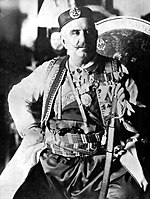
Nicholas I of Montenegro, the only king of Montenegro.
Principality of Montenegro
Main article: Principality of Montenegro
Flag of the Principality of Montenegro.
Under Nicholas I, the Principality was enlarged several times in the Montenegro-Turkish Wars and was recognised as independent in 1878. Under the rule of Nicholas I, diplomatic relations were established with the Ottoman Empire. Minor border skirmishes excepted, diplomacy ushered in approximately 30 years of peace between the two states until the deposition of Abdul Hamid II.
The political skills of Abdul Hamid and Nicholas I played a major role on the mutually amicable relations.[12] Modernization of the state followed, culminating with the draft of a Constitution in 1905. However, political rifts emerged between the reigning People’s Party that supported the process of democratization and union with Serbia and those of the True People’s Party who were monarchist.
During this period, one of the biggest in Montenegrin victories over the Ottomans occurred at the Battle of Grahovac. Grand Duke Mirko Petrović, elder brother of Knjaz Danilo, led an army of 7,500 and defeated the numerically superior Ottomans who had 13,000 troops at Grahovac on 1 May 1858. The glory of Montenegrin victory was soon immortalized in the songs and literature of all the South Slavs, in particular the Montenegrins in Vojvodina, then part of Austria-Hungary. This forced the Great Powers to officially demarcate the borders between Montenegro and Ottoman Empire, de facto recognizing Montenegro’s independence.
The first Montenegrin constitution was proclaimed in 1855; it was also known as the Danilo Code.
Kingdom of Montenegro (1910–1918)
Main article: Kingdom of Montenegro
In 1910 Montenegro became a Kingdom and as a result of the Balkan wars in 1912 and 1913 (in which the Ottomans lost all Balkan land), a common border with Serbia was established, with Shkodër being awarded to a newly created Albania. In World War I in 1914 Montenegro sided with Serbia against the Central Powers, suffering a full scale defeat to Austria-Hungary in early 1916. In 1918 the Allies liberated Montenegro, which was subsequently merged with Serbia.
Unification and Christmas Uprising
During World War I (1914–1918) Montenegro was allied with the Allied Powers. From 15 January 1916 to October 1918, Montenegro was occupied by Austria-Hungary. During occupation, King Nicholas fled first to Italy and then to France, and the government transferred its operations to Bordeaux. When the Allies liberated Montenegro, the Podgorica Assembly (Podgorička skupština, Подгоричка скупштина) was convened and voted to ban the king from returning and to unite the country with the Kingdom of Serbia on 1 December 1918. In the Christmas Uprising, a large part of the Montenegrin population[citation needed], known as the Greens (Zelenaši), rebelled against this decision to unify with Serbia and, led by their military leader Krsto Zrnov Popović, fought against the pro-unification forces, The whites (Bjelaši). The royal family was rehabilitated in 2011, by the government and today is headed by Crown Prince Nicholas II who has his own foundation.
Kingdom of Yugoslavia
Main article: Kingdom of Yugoslavia
In 1922 Montenegro formally became the “Oblast of Cettinje” of the Zeta Area in the Kingdom of Serbs, Croats and Slovenes, annexing for the first time the coastal areas that were former Albania Veneta. In a successive restructuring, in 1929 it became a part of a larger Zeta Banate of the Kingdom of Yugoslavia that reached the Neretva river.
Nicholas’s grandson, the Serb King Alexander I dominated the Yugoslav government. Zeta Banovina was one of nine bannovinas which formed the Kingdom and was named after the Serbian Medieval Principality Zeta. It consisted of the present-day Montenegro and parts of Serbia, Croatia and Bosnia.
Kingdom of Montenegro (1941–1944)
Main article: Kingdom of Montenegro (1941–1944)
In 1941, Benito Mussolini occupied Montenegro and annexed it to the Kingdom of Italy. The Queen of Italy, Elena of Montenegro influenced her husband Victor Emmanuel III to suggest that Mussolini make Montenegro independent of Yugoslavia. After the spring of 1942, much of the Sandžak region, which was included in the state of Montenegro, was not actually controlled by its government. The area of the Bay of Kotor (the Venetian Cattaro) was annexed to the Dalmatian province of Italy until September 1943. After the departure of the Italians, Montenegro remained under the direct control of German troops, with a terrible and bloody guerrilla war ravaging the area. In December 1944 the German troops withdrew and Josip Broz Tito’s Partisans assumed control.
Montenegro within Socialist Yugoslavia
Main article: Socialist Republic of Montenegro
Montenegro, like the rest of the Yugoslavia, was liberated by the Yugoslav Partisans in 1944. The first uprising in Axis-occupied Europe happened on 13 July 1941 in Montenegro,[13] when Montenegrins stood up against the fascists and joined Communist partisans. Notable Partisans from Montenegro include Arso Jovanović, Sava Kovačević, Svetozar Vukmanović-Tempo, Milovan Đilas, Peko Dapčević, Vlado Dapčević, Veljko Vlahović, Blažo Jovanović, Pavle Kapičić and Ivan Milutinović. Montenegro became a constituent of the six republics of the communist Socialist Federal Republic of Yugoslavia (SFRY), its capital became Podgorica renamed Titograd in honour of President Josip Broz Tito. After the war, the infrastructure of Yugoslavia was rebuilt, industrialization began and the University of Montenegro was established. Greater autonomy was established until the Socialist Republic of Montenegro ratified a new constitution 1974.
Dissolution of Socialist Yugoslavia and forming of FR Yugoslavia
Main articles: Serbia and Montenegro and Republic of Montenegro (1992–2006)
After the dissolution of the SFRY in 1992, Montenegro remained part of a smaller Federal Republic of Yugoslavia along with Serbia.
In the referendum on remaining in Yugoslavia in 1992, the turnout was 66% with 95.96% of the votes cast in favour the federation with Serbia. The referendum was boycotted by the Muslim, Albanian and Catholic minorities as well as the pro-independence Montenegrins. The opponents claimed that the poll was organized under anti-democratic conditions with widespread propaganda from the state-controlled media in favour of a pro-federation vote. There is no impartial report on the fairness of the referendum, as it was unmonitored, unlike in 2006 when European Union observers were present.
During the 1991–1995 Bosnian War and Croatian War, Montenegrin police and military forces joined Serbian troops in the attacks on Dubrovnik, Croatia.[14] These acts of aggression, aimed at acquiring more territory, were characterized by a consistent pattern of gross and systematic violation of human rights.[15]
Montenegrin General Pavle Strugar was convicted for his part in the bombing of Dubrovnik.[16] Bosnian refugees were arrested by Montenegrin police and transported to Serb camps in Foča, where they were subjected to systematic torture and executed.[17][18]
In 1996, Milo Đukanović’s government severed ties between Montenegro and the Serbian regime, which was then under Slobodan Milošević. Montenegro formed its own economic policy and adopted the German Deutsche Mark as its currency and subsequently adopted the Euro, although not part of the Eurozone currency union. Subsequent governments have pursued pro-independence policies and political tensions with Serbia simmered despite the political changes in Belgrade. Targets in Montenegro were bombed by NATO forces during Operation Allied Force in 1999, although the extent of these attacks was very limited in both time and area affected.[19]
In 2002, Serbia and Montenegro came to a new agreement regarding continued cooperation and entered into negotiations regarding the future status of the Federal Republic of Yugoslavia. In 2003, the Yugoslav federation was replaced in favour of a more decentralized state union named Serbia and Montenegro.
Independence
The status of the union between Montenegro and Serbia was decided by the referendum on Montenegrin independence on 21 May 2006. A total of 419,240 votes were cast, representing 86.5% of the total electorate. 230,661 votes (55.5%) were for independence and 185,002 votes (44.5%) were against.[20] The 45,659 difference narrowly surpassed the 55% threshold needed to validate the referendum under the rules set by the European Union. According to the electoral commission, the 55% threshold was passed by only 2,300 votes. Serbia, the member-states of the European Union, and the permanent members of the United Nations Security Council all recognised Montenegro’s independence.
The 2006 referendum was monitored by five international observer missions, headed by an Organization for Security and Co-operation in Europe (OSCE)/ODIHR team, and around 3,000 observers in total (including domestic observers from CEMI, CEDEM and other organizations). The OSCE/ODIHR joined efforts with the observers of the OSCE Parliamentary Assembly (OSCE PA), the Parliamentary Assembly of the Council of Europe (PACE), the Congress of Local and Regional Authorities of the Council of Europe (CLRAE) and the European Parliament (EP) to form an International Referendum Observation Mission (IROM). The IROM—in its preliminary report—”assessed compliance of the referendum process with OSCE commitments, Council of Europe commitments, other international standards for democratic electoral processes, and domestic legislation.” Furthermore, the report assessed that the competitive pre-referendum environment was marked by an active and generally peaceful campaign and that “there were no reports of restrictions on fundamental civil and political rights.”
On 3 June 2006, the Montenegrin Parliament declared the independence of Montenegro,[21] formally confirming the result of the referendum. Serbia did not object to the declaration.
Relations between Serbia and Montenegro were strained on 6 September 2007 after Montenegro banned Serbian Orthodox Church leader Bishop Filaret from entering the country. Tension escalated when an adviser to the Serbian prime minister referred to Montenegro as a “quasi-state”, prompting Podgorica to seek an apology and lodge a protest with Serbia’s government.[22] The Deputy Prime Minister of Serbia, Božidar Đelić, sent a note of apology to Montenegro following the statement made by Serbian Premier’s Aide Aleksandar Simic.[23][24]
Geography
Main article: Geography of Montenegro

Lake in Durmitor National Park
Internationally, Montenegro borders Croatia, Bosnia and Herzegovina, Serbia, Kosovo[a], and Albania. It lies between latitudes 41° and 44° N, and longitudes 18° and 21° E.
Montenegro ranges from high peaks along its borders with Serbia and Albania, a segment of the Karst of the western Balkan Peninsula, to a narrow coastal plain that is only one to four miles (6 km) wide. The plain stops abruptly in the north, where Mount Lovćen and Mount Orjen plunge into the inlet of the Bay of Kotor.
Montenegro’s large Karst region lies generally at elevations of 1,000 metres (3,280 ft) above sea level; some parts, however, rise to 2,000 m (6,560 ft), such as Mount Orjen (1,894 m/6,214 ft), the highest massif among the coastal limestone ranges. The Zeta River valley, at an elevation of 500 m (1,600 ft), is the lowest segment.
The mountains of Montenegro include some of the most rugged terrain in Europe, averaging more than 2,000 metres in elevation. One of the country’s notable peaks is Bobotov Kuk in the Durmitor mountains, which reaches a height of 2,522 metres (8,274 ft). Owing to the hyperhumid climate on their western sides, the Montenegrin mountain ranges were among the most ice-eroded parts of the Balkan Peninsula during the last glacial period.
- Longest beach: Velika Plaža, Ulcinj — 13,000 m (8.1 mi)
- Highest peak: Zla Kolata, Prokletije at 2,534 m
- Largest lake: Skadar Lake — 391 km2 (151 sq mi) of surface area
- Deepest canyon: Tara River Canyon — 1,300 m (4,300 ft)
- Biggest bay: Bay of Kotor
- National parks: Durmitor — 390 km2 (150 sq mi), Lovćen — 64 km2 (25 sq mi), Biogradska Gora — 54 km2 (21 sq mi), Skadar Lake — 400 km2 (154 sq mi)
- UNESCO World Heritage sites: Durmitor and Tara River Canyon, old city of Kotor.
Montenegro is a member of the International Commission for the Protection of the Danube River (ICPDR), as more than 2000 square kilometres of the country’s territory lie within the Danube catchment area.
Biodiversity
Diversity of geological base, landscape, climate and soil, as well as the very position of Montenegro on the Balkan peninsula and Adriatic sea, created conditions for formation of biological diversity with very high values, that puts Montenegro among biological „hot-spots“ of European and world’s biodiversity. Number of species per area unit Index in Montenegro is 0.837, which is the highest index recorded in all European countries.[25]
Biodiversity outlook
- Freshwater algea of Montenegro – so far 1200 species and varieties has been described
- Vascular flora of Montenegro has 3250 species. Number of endemics is also high – there are 392 Balkan’s (regional) endemic species, equivalent to over 7% of Montenegrin flora.
- Skadar lake is among the most important areas that are inhabited by the freshwater fish, where 40 species of fish, including species that migrate from marine to freshwater ecosystem, like eel (Anguilla Anguilla), shad (Alossa falax nilotica) etc.
- It is considered that the diversity of marine fish fauna of the Adriatic sea comprise 117 registered families but with low level of endemism. To date, 40 742 marine fish species have been registered in Montenegro which represents 70% of species registered in Mediterranean.
- There are currently 56 species (18 amphebian and 38 reptile species) and 69 subspecies recorded within 38 genera and the list is probably not the final. Mountain regions of Lovćen and Prokletije stand out as particularly hot spots of amphebians and reptiles in Montenegro.
- Out of 526 European bird species 333 are assumed to be regularly present in Montenegro. Out of them, 204 species are nesting in the country.[26]
Governance
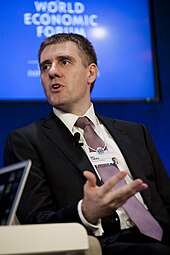
Prime Minister Igor Lukšić
Main article: Politics of Montenegro
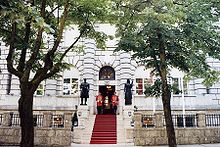
Presidential Palace, Cetinje
See also: Foreign relations of Montenegro and Military of Montenegro
The Constitution of Montenegro describes the state as a “civic, democratic, ecological state of social justice, based on the reign of Law.”[27] Montenegro is an independent and sovereign republic that proclaimed its new constitution on 22 October 2007.

President Filip Vujanović
The President of Montenegro (Montenegrin: Predsjednik Crne Gore) is the head of state, elected for a period of five years through direct elections. The President represents the republic abroad, promulgates laws by ordinance, calls elections for the Parliament, proposes candidates for Prime Minister, president and justices of the Constitutional Court to the Parliament. The President also proposes the calling of a referendum to Parliameny, grants amnesty for criminal offences prescribed by the national law, confers decoration and awards and performs other constitutional duties and is a member of the Supreme Defence Council. The official residence of the President is in Cetinje.
The Government of Montenegro (Montenegrin: Vlada Crne Gore) is the executive branch of government authority of Montenegro. The government is headed by the Prime Minister, and consists of the deputy prime ministers as well as ministers.
The Parliament of Montenegro (Montenegrin: Skupština Crne Gore) is a unicameral legislative body. It passes laws, ratifies treaties, appoints the Prime Minister, ministers, and justices of all courts, adopts the budget and performs other duties as established by the Constitution. Parliament can pass a vote of no-confidence on the Government by a simple majority. One representative is elected per 6,000 voters. The present parliament contains 81 seats, with a 47-seat majority currently held by the Coalition for a European Montenegro as a result of the 2009 parliamentary election.
Symbols
An official flag of Montenegro, based on the royal standard of King Nikola I was adopted on 12 July 2004 by the Montenegrin legislature. This royal flag was red with a silver border, a silver coat of arms, and the initials НІ in Cyrillic script (corresponding to NI in Latin script) representing King Nikola I. On the current flag, the border and arms are in gold and the royal cipher in the centre of the arms was replaced with a golden lion.
The national day of 13 July marks the date in 1878 when the Congress of Berlin recognized Montenegro as the 27th independent state in the world[28] and the start of one of the first popular uprisings in Europe against the Axis Powers on 13 July 1941 in Montenegro.
In 2004, the Montenegrin legislature selected a popular Montenegrin traditional song, Oh, Bright Dawn of May, as the national anthem. Montenegro’s official anthem during the reign of King Nikola was Ubavoj nam Crnoj Gori (To our beautiful Montenegro).
Military
Main article: Military of Montenegro
The Military of Montenegro is composed of an army, navy, air force, and a special forces component. As of 2009 it is organized as a fully professional standing army under the Ministry of Defence with the aim of protecting and defending Montenegro sovereignty. Montenegro’s goal is to eventually join NATO after modernization and reorganization of its military.[29] Future plans for the army are to participate in peacekeeping missions through various UN and NATO efforts such as the International Security Assistance Force.[30]
Administrative divisions
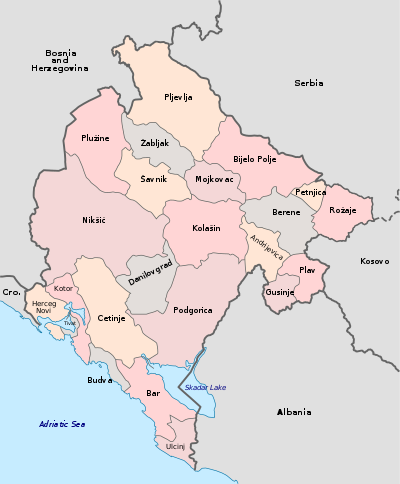
Municipalities of Montenegro
Main article: Municipalities of Montenegro
Montenegro is divided into twenty-one municipalities (opština), and two urban municipalities, subdivisions of Podgorica municipality, listed below. Each municipality can contain multiple cities and towns. Historically, the territory of the country was divided into “nahije”.
- Andrijevica
- Bar
- Berane
- Bijelo Polje
- Budva
- Cetinje
- Danilovgrad
- Herceg Novi
- Kolašin
- Kotor
- Mojkovac
- Nikšić
|
- Plav
- Plužine
- Pljevlja
- Podgorica
- Rožaje
- Šavnik
- Tivat
- Ulcinj
- Žabljak
|
|
Cities in Montenegro
Main article: List of cities in Montenegro
| Some of the biggest cities and towns in Montenegro are: |
| City |
City
Population |
Coat
of arms |
| Podgorica (Capital) |
156,169 |
 |
| Nikšić |
57,278 |
 |
| Bijelo Polje |
23,105 |
|
| Pljevlja |
19,622 |
 |
| Herceg Novi |
19,617 |
 |
| Bar |
17,727 |
 |
| Cetinje |
14,166 |
 |
| Berane |
11,193 |
|
| Rožaje |
9,567 |
 |
Economy
Main article: Economy of Montenegro
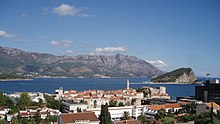
Budva is one of the main tourist destinations
The economy of Montenegro is mostly service-based and is in late transition to a market economy. According to the International Monetary Fund, the nominal GDP of Montenegro was $4.114 billion in 2009. The GDP PPP for 2009 was $6.590 billion, or $10,527 per capita.[31]
GDP grew at an impressive 10.7% in 2007 and 7.5% in 2008.[31] The country entered a recession in 2008 as a part of the global recession, with GDP contracting by 4%. However, Montenegro remained a target for foreign investment, the only country in the Balkans to increase its amount of direct foreign investment.[32] The country is expected to exit the recession in mid-2010, with GDP growth predicted at around 0.5%.[33] However, the significant dependence of the Montenegrin economy on foreign direct investment leaves it susceptible to external shocks and a high export/import trade deficit.
In 2007, the service sector made up for 72.4% of GDP, with industry and agriculture making up the rest at 17.6% and 10%, respectively.[34]
According to Eurostat data, the Montenegrin GDP per capita stood at 41% of the EU average in 2010.[35]
Aluminum and steel production and agricultural processing make up for most of the industrial output.
Tourism is an important contributor to Montenegrin economy. Approximately one million tourists visited Montenegro in 2007, resulting in €480 million of tourism revenue. Tourism is considered the backbone of future economic growth, and government expenditures on infrastructure improvements are largely target towards that goal.
Infrastructure
Main article: Transport in Montenegro
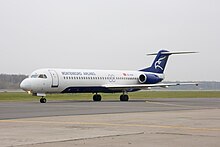
Montenegro Airlines is the Montenegrin national airline.
The Montenegrin road infrastructure is not yet at Western European standards. Despite an extensive road network, no roads are built to full motorway standards. Construction of new motorways is considered a national priority, as they are important for uniform regional economic development and the development of Montenegro as an attractive tourist destination.
Current European routes that pass through Montenegro are E65 and E80.
The backbone of the Montenegrin rail network is the Belgrade – Bar railway. This railway intersects with Nikšić – Tirana (Albania) at Podgorica; however, it is not used for passenger service.
Montenegro has two international airports, Podgorica Airport and Tivat Airport. The two airports served 1.1 million passengers in 2008. Montenegro Airlines is the flag carrier of Montenegro.
The Port of Bar is Montenegro’s main seaport. Initially built in 1906, the port was almost completely destroyed during World War II, with reconstruction beginning in 1950. Today, it is equipped to handle over 5 million tons of cargo annually, though the breakup of the former Yugoslavia and the size of the Montenegrin industrial sector has resulted in the port operating at a loss and well below capacity for several years. The reconstruction of the Belgrade-Bar railway and the proposed Belgrade-Bar motorway are expected to bring the port back up to capacity.
Tourism
Main article: Tourism in Montenegro
Montenegro has both a picturesque coast and a mountainous northern region. The country was a well-known tourist spot in the 1980s. Yet, the Yugoslav wars that were fought in neighbouring countries during the 1990s crippled the tourist industry and destroyed the image of Montenegro as a tourist destination.
The Montenegrin Adriatic coast is 295 km (183 mi) long, with 72 km (45 mi) of beaches, and with many well-preserved ancient old towns. National Geographic Traveler (edited once in decade) features Montenegro among the “50 Places of a Lifetime”, and Montenegrin seaside Sveti Stefan was used as the cover for the magazine.[36] The coast region of Montenegro is considered one of the great new “discoveries” among world tourists. In January 2010, The New York Times ranked the Ulcinj South Coast region of Montenegro, including Velika Plaza, Ada Bojana, and the Hotel Mediteran of Ulcinj, as among the “Top 31 Places to Go in 2010” as part of a worldwide ranking of tourism destinations.[37] Montenegro was also listed in “10 Top Hot Spots of 2009” to visit by Yahoo Travel, describing it as “Currently ranked as the second fastest growing tourism market in the world (falling just behind China)”.[38] It is listed every year by prestigious tourism guides like Lonely Planet as top touristic destination along with Greece, Spain and other world touristic places[39][40]
It was not until the 2000s that the tourism industry began to recover, and the country has since experienced a high rate of growth in the number of visits and overnight stays. The Government of Montenegro has set the development of Montenegro as an elite tourist destination a top priority. It is a national strategy to make tourism a major contributor to the Montenegrin economy. A number of steps were taken to attract foreign investors. Some large projects are already under way, such as Porto Montenegro, while other locations, like Jaz Beach, Buljarica, Velika Plaža and Ada Bojana, have perhaps the greatest potential to attract future investments and become premium tourist spots on the Adriatic.
-
Miriste Beach, Herceg Novi
-
-
A view of Sveti Stefan island in the Budva municipality.
-
Biogradska Gora, one of the few remaining European rain forests and a national park in Kolašin.
-
Tara River Canyon, deepest canyon in Europe and the second-deepest in the world.
Demographics
|
|
This article needs additional citations for verification. Please help improve this article by adding citations to reliable sources. Unsourced material may be challenged and removed. (January 2010) |
Main articles: Demographics of Montenegro and Demographic history of Montenegro
| Historical populations |
| Year |
Pop. |
±% |
| 1900 |
311,564 |
— |
| 1909 |
317,856 |
+2.0% |
| 1921 |
311,341 |
−2.0% |
| 1931 |
360,044 |
+15.6% |
| 1948 |
377,189 |
+4.8% |
| 1953 |
419,873 |
+11.3% |
| 1961 |
471,894 |
+12.4% |
| 1971 |
529,604 |
+12.2% |
| 1981 |
584,310 |
+10.3% |
| 1991 |
615,035 |
+5.3% |
| 2003 |
620,145 |
+0.8% |
| 2011 |
625,266 |
+0.8% |
Ethnic structure

Ethnic structure of Montenegro by settlements, 2011.
According to the 2003 census, Montenegro has 620,145 citizens. If the methodology used up to 1991 had been adopted in the 2003 census, Montenegro would officially have recorded 673,094 citizens. The results of the 2011 census show that Montenegro has 620,029 citizens.[41]
When the 2003 census was taken Montenegro was a non-national civic state. In the meantime, the Constitution was changed, hence it now recognizes the major ethnic groups: Montenegrins (Crnogorci), Serbs (Srbi), Bosniaks (Bošnjaci), Muslims (Muslimani), Albanians (Albanci – Shqiptarët) and Croats (Hrvati). Thus, the number of “Montenegrins” and “Serbs” fluctuates wildly from census to census due to changes in how people experience, or choose to express, their identity.[42]
Ethnic composition according to the 2011 official data:[41]
|
Number |
% |
| Total |
620,029 |
100 |
| Montenegrins |
278,865 |
44.98 |
| Serbs |
178,110 |
29.73 |
| Bosniaks |
53,605 |
8.65 |
| Albanians |
30,439 |
4.91 |
| Muslims by nationality |
20,537 |
3.31 |
| Roma |
6,251 |
1.01 |
| Croats |
6,021 |
0.97 |
| Serbo-Montenegrins |
2,103 |
0.34 |
| Egyptians |
2,054 |
0.33 |
| Montenegrins-Serbs |
1,833 |
0.30 |
| Yugoslavs |
1,154 |
0.19 |
| Russians |
946 |
0.15 |
| Macedonians |
900 |
0.15 |
| Bosnians |
427 |
0.07 |
| Slovenes |
354 |
0.06 |
| Hungarians |
337 |
0.05 |
| Muslim-Montenegrins |
257 |
0.04 |
| Gorani people |
197 |
0.03 |
| Muslim-Bosniaks |
183 |
0.03 |
| Bosniaks-Muslims |
181 |
0.03 |
| Montenegrin-Muslims |
175 |
0.03 |
| Italians |
135 |
0.02 |
| Germans |
131 |
0.02 |
| Turks |
104 |
0.02 |
| regional qualification |
1.202 |
0.19 |
| without declaration |
3.0170 |
4.87 |
| other |
3.358 |
0.54 |
Linguistic structure

Linguistic structure of Montenegro by settlements, 2011.
Most citizens speak the Serbian language of the Ijekavian dialect. However, as of 2004 moves for an independent Montenegrin language were promoted and with the new 2007 Constitution it became Montenegro’s prime official language. Next to it, Serbian, Bosnian, Albanian and Croatian are recognized in usage. All of these languages except for Albanian are mutually intelligible. According to the 2011 census, the following languages are spoken in the country[41]:
|
Number |
% |
| Total |
620.029 |
100 |
| Serbian |
265,895 |
42.88 |
| Montenegrin |
229,251 |
36.97 |
| Bosnian |
33,077 |
5.33 |
| Albanian |
32,671 |
5.27 |
| Serbo-Croatian |
12,559 |
2.03 |
| Roma |
5,169 |
0.83 |
| Bosniak |
3,662 |
0.59 |
| Croatian |
2,791 |
0.45 |
| Russian |
1,026 |
0.17 |
| Serbo-Montenegrin |
618 |
0.10 |
| Macedonian |
529 |
0.09 |
| Montenegrin-Serbian |
369 |
0.06 |
| Hungarian |
225 |
0.04 |
| Croatian-Serbian |
224 |
0.04 |
| English |
185 |
0.03 |
| German |
129 |
0.02 |
| Slovene |
107 |
0.02 |
| Romanian |
101 |
0.02 |
| mother tongue |
3.318 |
0.54 |
| regional languages |
458 |
0.07 |
| without declaration |
24.748 |
3.99 |
| other |
2.917 |
0.47 |
Religious structure

Religious structure of Montenegro by settlements, 2011.
Most Montenegrin inhabitants are Orthodox Christians, followers of the Serbian Orthodox Church’s Metropolitanate of Montenegro and the Littoral and the Montenegrin Orthodox Church. The religious institutions all have guaranteed rights and are separate from the state. There is a sizeable number of Sunni Muslims Montenegrins that maintain their own Islamic Community of Montenegro. Religious tolerance has been hailed as a model for the region, with a protocol passed in 2012 that recognises Islam as an official religion in Montenegro, ensures that halal foods will be served at military facilities, hospitals, dormitories and all social facilities; and that Muslim women will be permitted to wear headscarves in schools and at public institutions, as well as ensuring that Muslims have the right to take Fridays off work for the Jumu’ah (Friday)-prayer.[43] There is also a small Roman Catholic population, divided between the Archdiocese of Antivari headed by the Primate of Serbia and the Diocese of Kotor that is a part of the Church of Croatia. Religious determination according to the 2011 census:[41]
|
Number |
% |
| Total |
620,029 |
100 |
| Eastern Orthodox |
446,858 |
72.07 |
| Islam/ Muslims |
118,477
(99,038 Islam, 19,439 Muslims) |
19.11
(15.97 Islam, 3.14 Muslims) |
| Catholics |
21,299 |
3.44 |
| Atheism |
7,667 |
1.24 |
| Christians |
1,460 |
0.24 |
| Adventists |
894 |
0.14 |
| Agnostics |
451 |
0.07 |
| Jehovah’s Witnesses |
145 |
0.02 |
| Protestants |
143 |
0.02 |
| Buddhists |
118 |
0.02 |
| other |
6,337 |
1.02 |
| without declaration |
16,180 |
2.61 |
- Note: In the 2011 census, there are two separate columns for the adherents of the Islam, one is called Islam, the other Muslims.
Education
Main article: Education in Montenegro
Main building of The University of Montenegro.
Education in Montenegro is regulated by the Montenegrin Ministry of Education and Science.
Education starts in either pre-schools or elementary schools. Children enroll in elementary schools (Montenegrin: Osnovna škola) at the age of 6; it lasts 9 years. The students may continue their secondary education (Montenegrin: Srednja škola), which lasts 4 years (3 years for trade schools) and ends with graduation (Matura). Higher education lasts with a certain first degree after 3 to 6 years. There is one public University (University of Montenegro) and two private (University “Mediterranean” and University of Donja Gorica).
Elementary education
Elementary education in Montenegro is free and compulsory for all the children between the ages of 6 and 14.
Secondary education
Secondary schools are divided in three types, and children attend one depending on choice and primary school grades:
- Gymnasium (Gimnazija / Гимназиjа), lasts for four years and offers a general, broad education. It is a preparatory school for university, and hence the most academic and prestigious.
- Professional schools (Stručna škola / Стручна школа) last for three or four years and specialize students in certain fields which may result in them attending college; professional schools offer a relatively broad education.
- Vocational schools (Zanatska škola / Занатска школа) last for three years and focus on vocational education (e.g., joinery, plumbing, mechanics) without an option of continuing education after three years.
Tertiary education
Tertiary level institutions are divided into “Higher education” (Više obrazovanje) and “High education” (Visoko obrazovanje) level faculties.
- Colleges (Fakultet) and art academies (akademija umjetnosti) last between 4 and 6 years (one year is two semesters long) and award diplomas equivalent to a Bachelor of Arts or a Bachelor of Science degree.
Higher schools (Viša škola) lasts between two and four years.
Post-graduate education
Post-graduate education (post-diplomske studije) is offered after tertiary level and offers Masters’ degrees, PhD and specialization education.
Culture
Main article: Culture of Montenegro
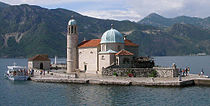
The Church of Our Lady of the Rocks, an example of Roman Catholic architecture in Montenegro.

National Museum of Montenegro in Cetinje (Former Palace of King Nikola I)
The culture of Montenegro has been shaped by a variety of influences throughout history. The influence of Orthodox, Slavonic, Central European, Islamic, and seafaring Adriatic cultures (notably parts of Italy, like the Republic of Venice) have been the most important in recent centuries.
Montenegro has many significant cultural and historical sites, including heritage sites from the pre-Romanesque, Gothic and Baroque periods. The Montenegrin coastal region is especially well known for its religious monuments, including the Cathedral of Saint Tryphon in Kotor[44] (Cattaro under the Venetians), the basilica of St. Luke (over 800 years), Our Lady of the Rocks (Škrpjela), the Savina Monastery and others. Montenegro’s medieval monasteries contain thousands of square metres of frescos on their walls.
The traditional folk dance of the Montenegrins is the Oro, a circle dance that involves dancers standing on each other’s shoulders in a circle while one or two dancers are dancing in the middle.
The first literary works written in the region are ten centuries old, and the first Montenegrin book was printed five hundred years ago. The first state-owned printing press was located in Cetinje in 1494, where the first South Slavic book, Oktoih, was printed the same year. Ancient manuscripts, dating from the thirteenth century, are kept in the Montenegrin monasteries.[45]
Montenegro’s capital Podgorica and the former royal capital of Cetinje are the two most important centres of culture and the arts in the country.
Ethical beliefs
A very important dimension of Montenegrin culture is the ethical ideal of Čojstvo i Junaštvo, “Humaneness and Gallantry”.[46][47]
Sport
Main article: Sport in Montenegro
The most popular sports in Montenegro are football, basketball, water polo, volleyball, and handball. Other relatively important sports include boxing, judo, karate, athletics, table tennis, and chess.
Previously, all of Montenegro’s national teams were known as Yugoslavian national teams, as Montenegro was part of Yugoslavia. On 24 March 2007, the Montenegrin national football team came from behind to win its first ever fixture, 2-1 in a friendly game against Hungary, at the Podgorica Stadium.[48] The main football club in Montenegro is FK Budućnost Podgorica from capital Podgorica.[49] At their 119th Session in Guatemala City in July 2007, the International Olympic Committee granted recognition and membership to the newly formed Montenegrin National Olympic Committee. Montenegro made its debut at the 2008 Summer Olympics in Beijing.[50] Montenegro hosted together with Serbia the EuroBasket 2005 championships.[51]
Water polo is often considered the national sport. Montenegro won the European Championships in Málaga, Spain on 13 July 2008, over Serbia 6-5 in a game that was tied 5–5 after four quarters.[52] This was Montenegro’s first major international competition for which they had to qualify through two LEN tournaments. Montenegro won the gold medal at the 2009 FINA Men’s Water Polo World League, which was held in Podgorica.[53] Montenegrin team PVK Primorac from Kotor became a champion of Europe at the LEN Euroleague 2009 in Rijeka, Croatia. Montenegro’s first division in water polo consists of six clubs, four of them with an annual budget of one million Euros and more — VK Primorac Kotor (2007 and 2008 Montenegro champions), VK Jadran Herceg Novi (2006 champions of Serbia-Montenegro), VK Budvanska Rivijera Budva, and VK Cattaro. Montenegro’s water polo Olympic team finished fourth overall at the 2008 Olympic Games in Beijing.
Cuisine
Main article: Montenegrin cuisine
Montenegrin cuisine is a result of Montenegro’s long history. It is a variation of Mediterranean and Oriental. The most influence is from Italy, Turkey, Byzantine Empire/Greece, and as well from Hungary. Montenegrin cuisine also varies geographically; the cuisine in the coastal area differs from the one in the northern highland region. The coastal area is traditionally a representative of Mediterranean cuisine, with seafood being a common dish, while the northern represents more the Oriental.
In popular culture
The first official international representation of Montenegro as an independent state was in Miss World 2006, held on 30 September 2006 in Warsaw, Poland. Ivana Knežević from the city of Bar was the first Miss Montenegro at any international beauty pageant.[54] Both Montenegro and Serbia competed separately in this pageant for the first time after the state union came to an end.
Part of the 2006 James Bond film Casino Royale is set in Montenegro,[55] although most of the filming was done in the Czech Republic.
Nero Wolfe, the eccentric fictional detective created by American writer Rex Stout, is Montenegrin by birth.[56] One Nero Wolfe novel, The Black Mountain, takes place in Tito-era Montenegro.
The setting for Franz Lehár’s 1905 operetta The Merry Widow is the Paris embassy of the Grand Duchy of Pontevedro. Pontevedro is a fictionalized version of Montenegro and several of the characters were loosely based on actual Montenegrin nobility.
This location is featured in The Brothers Bloom, where Bloom moves to escape his brother in the beginning, and in the end, where he ends up living.
In F. Scott Fitzgerald’s Novel The Great Gatsby, Gatsby impresses Nick that he has been awarded a World War I medal “for Valour Extraordinary” from Montenegro.[57]
Montenegrin holidays
Holidays
| Date |
Name |
Notes |
| 1 January |
New Year’s Day |
(non-working holiday) |
| 7 January |
Orthodox Christmas |
(non-working) |
| 13 April |
Orthodox Good Friday |
Date for 2012 only |
| 15 April |
Orthodox Easter |
Date for 2012 only |
| 16 April |
Orthodox Easter Monday |
Date for 2012 only |
| 1 May |
Labor Day |
(non-working) |
| 9 May |
Victory Day |
|
| 21 May |
Independence Day |
(non-working) |
| 13 July |
Statehood Day |
(non-working) |
See also
 |
Geography portal |
 |
Europe portal |
 |
Montenegro portal |
- Outline of Montenegro
- Communications in Montenegro
- Cuisine of Montenegro
- Culture of Montenegro
- Economy of Montenegro
- Foreign relations of Montenegro
- History of Yugoslavia
- History of the Balkans
- Languages of Montenegro
- Law enforcement in Montenegro
- List of rulers of Montenegro
- Military of Montenegro
- Montenegrin independence referendum
- Montenegrin Orthodox Church
- Montenegrin perper
- Music of Montenegro
- Politics of Montenegro
- Savez Izviđača Crne Gore
- Sport in Montenegro
- Tourism in Montenegro
- Transport in Montenegro
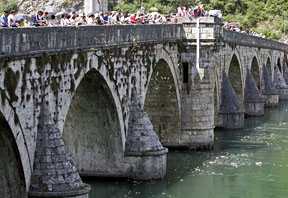 The Drina Bridge in BiH was one of the structures that was restored. [Reuters]
The Drina Bridge in BiH was one of the structures that was restored. [Reuters]





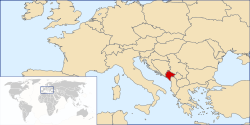
 42°47′N 19°28′E
42°47′N 19°28′E
![Good news for Montenegro 11 Location of Montenegro (Green)in Europe (Dark Grey) — [Legend]](https://upload.wikimedia.org/wikipedia/commons/thumb/b/b0/Europe-Montenegro.svg/250px-Europe-Montenegro.svg.png)

